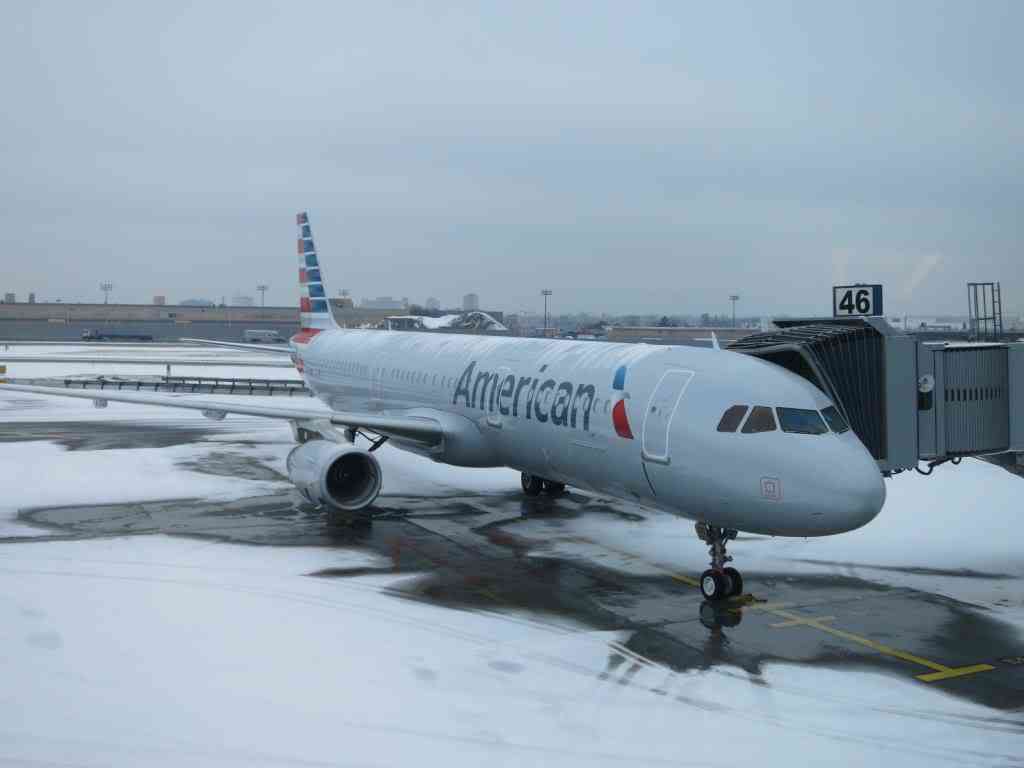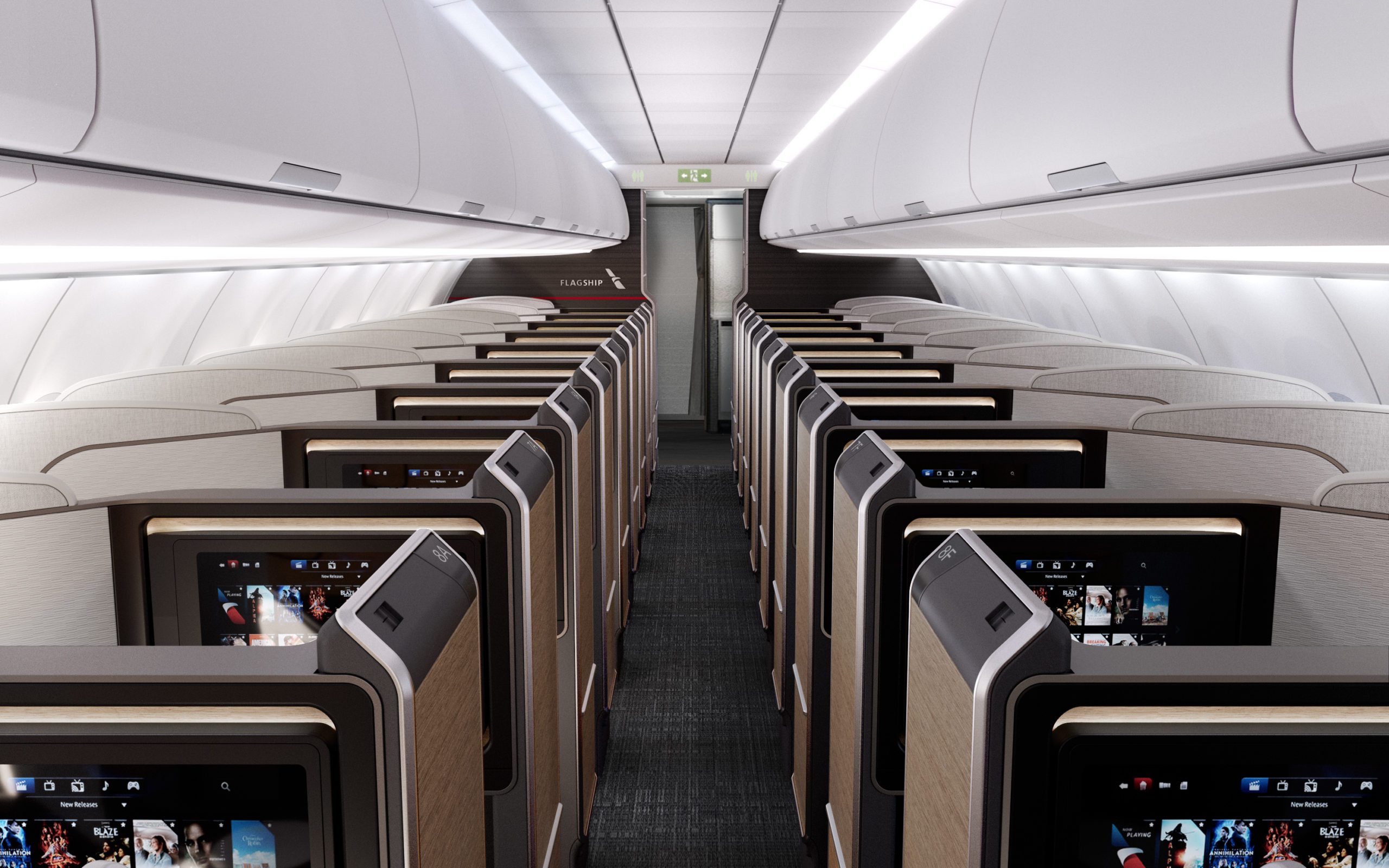American is opening schedule bidding for pilots on the Airbus A321XLR from New York JFK in February, for flights to begin in March 2026. American has planned to run these brand new narrowbody planes from New York to Los Angeles and San Francisco, since they offer flat bed suites in business class and will have a premium economy.
Airbus A321XLRs will replace the 2014-era Airbus A321T planes with first, business and coach seats, which will get converted to the standard domestic narrowbody product.
However American here is explicit that they will run flights to Europe from New York JFK using these brand new A321XLR narrowbody planes as “the primary mission” though “specific routes…have not yet been finalized” as first reported by aviation watchdog JonNYC.
American will start with 40 pilots and grow this “steadily over time…throughout 2026” as more planes are delivered and more pilots obtain the necessarily qualifications.
AA: XLR pilots, JFK pic.twitter.com/hAoOIAraG9
— JonNYC (@xJonNYC) August 28, 2025
The airline had ordered 50 of these planes and they were originally supposed to be delivered 8 in 2023, 22 in 2024, and 20 in 2025 but they’ve faced delays.
The aircraft may not have the full range originally hoped for but can easily operate out of New York and Philadelphia. There’s been talk in the past about also flying the XLR from Charlotte, Chicago and Miami.
The suggestion here seems to be that they are going to focus on transatlantic growth before moving the full premium cross-country operation to these new planes. American has already started scheduling some widebodies on cross-country flights.

American Airlines Airbus A321 at New York JFK
United, American and JetBlue are all counting on the new XLR. So are Air Canada, Qantas, and numerous other carriers. American in particular needs this aircraft because they’ve retired their Boeing 757, 767, and Airbus A330s so they have limited transatlantic capacity.
No airline has really proven they can make a narrowbody work well across the Atlantic. The cost per seat will be higher than for a widebody, even though the trip cost is lower.
- If you aren’t going to fill a widebody, then a narrowbody might still make money or break even (regardless you’ll lose less). That’s especially important in winter.
- American doesn’t have the robust connecting hub that Delta has at JFK and United has at Newark. The government blocked their partnership with JetBlue which would have created a real third competitor to the New York duopoly.
- Sending A321XLRs transatlantic is a strategy to try something beyond flying to joint venture partner hubs from New York. They’re eventually going to need to use their New York slots and this is showing real signs of strategic life out of Dallas.
- They’ll be able to support two flights to some destinations with an XLR instead of a single widebody (greater flexibility in schedule and picking up more passengers overall) and will be able to add some secondary European cities as well. It’s also an opportunity to run flights year-round that would otherwise only work in summer when it’s possible to fill a widebody.

A321XLR Business Class, Credit: American Airlines

A321XLR Premium Economy, Credit: American Airlines
While I love the spaciousness of a widebody aircraft, I’m really looking forward to the premium experience on these planes. And I’m looking forward to a premium experience on routes that didn’t previously support one.


Love your comment, Gary: “If you aren’t going to fill a widebody, then a narrowbody might still make money or break even (regardless you’ll lose less)”. You’ve just summarized the entire Global Strategy of American Airlines: “We aim to lose less”. Not exactly aspirational, but that sure seems to be what they’re going for.
Is it reasonable to be concerned that a route is close to the maximum range of the aircraft? Or do all flights have similar margin for trouble given that they are only fueled to the extent necessary?
“No airline has really proven they can make a narrowbody work well across the Atlantic. ”
EI has been doing a solid job of that for a while.
At least these have Premium Economy. Some airlines (like Iberia) are just doing Y and J.
This sounds less like a growth strategy then a process to down gauge with a more premium rich environment.
this is the operative statement
“No airline has really proven they can make a narrowbody work well across the Atlantic. The cost per seat will be higher than for a widebody, even though the trip cost is lower.”
You need only look at B6 vs. DL in BOS (and JFK) to see why bringing a narrowbody to a fight w/ a carrier that uses widebodies doesn’t work.
Not only do US labor costs make the idea of using a narrowbody on an 8 hour plus flight unworkable (and even some less than that) but the widebody is often twice the passenger capacity PLUS cargo revenue.
and a narrowbody might be comparable in business class but it is markedly worse than a widebody such as the 767 or A330 in economy.
A321XLRs might make sense from PHL or CLT but not from competitive hubs; but let’s face it that this is about the 16th iteration of AA’s “this will fix our NYC problem”
Ben,
Ireland and Iceland are both close enough that you don’t even need an XLR – a regular 321NEO with additional tanks can work.
and Ireland and Iceland are within 8 hours of many points in the eastern US.
AA and UA intend to deploy their XLRs to continental Europe.
The good news about the XLR is that they can and will function on domestic premium routes. I suspect AA and UA will quickly find out that the economics of the XLR are just not that great, esp. on 8+ hour flights where they need 3 pilots.
AA’s transatlantic system barely breaks even compared to DL’s that makes over $1 billion in profit per year and UA that gets 80% of that with UA’s larger size coming from flying narrowbodies (757s and 737s) across the Atlantic.
The only benefit of the XLR is that it provides for flex capacity to fly to Europe which can then be used on domestic routes outside of the peak summer season. but the XLR is an expensive plane to acquire – far more expensive per seat than widebodies – and fuel is not going to go up given that the current US strategy is to keep US production high to counter a whole bunch of geopolitical issues.
‘HECK YEAH, WE FLY THERE!’ (Oh, wait, that might be United… whoopsie.)
If this AA 321LXR update is for real, I’m excited for it; while those won’t have ‘Flagship First’ the new suites onboard are probably superior, and Soho lounge at JFK is plenty good enough (sorry, Chelsea… for another time, girl…)
Is AA serious about making JFK an international gateway, or have they resigned that to PHL and CLT? Narrowbodies tell me that they just see JFK as a means of handling New York O&D traffic.
Yes the AA leadership in Dallas is SO brilliant.
It’s only been 20 years since Continental blitzed Europe with transatlantic 757 service.
https://www.airliners.net/forum/viewtopic.php?t=1447413
Can’t wait for their next innovation!
I’m extremely skeptical about this move but I will give American some props for at trying to do something different.
@Pat — I don’t see why AA couldn’t handle simultaneous ‘hubs’ at JFK, PHL, and CLT. Like, I applaud them for attempting this mid-Atlantic ‘triple-penetration’ strategy… and, please, for once, don’t neglect the CLT!
(This post goes well with Gary’s other one from earlier today about the Admirals Club renovations planned for Charlotte; long-overdue!)
Maybe winter flying on some thin routes where there’s premium demand?
After mulling on the XLR experience so far, it’s reminding me of the A310 from NYC to European destinations back in the 1990s. There were compromises in terms of range and passenger experience… but now with the LR/XLR to see the challenges with the smaller galleys/food storage and the reduced number of lavatories, how many compromises can you make to fill out your route map especially from a major OD point such as NYC.
1990,
the problem is that you can’t decide to just focus on the local market while you have competitors that aggressively compete for the local market AND all of the flow traffic that helps fill planes that have better economics.
There just is not that much premium traffic to Europe for 6 months per year. Narrowbodies will work for 6 months per year even given the longer summer season but you have to pay the mortgage and crew salaries for 12 months per year.
DL and UA are growing in the S. Pacific and AA also has S. America to shift widebodies to in the U.S. winter but narrowbodies are either going to lose money flying the Atlantic for 4 or more months per year or get reallocated to domestic markets.
and to dovpilot’s point, you can make a narrowbody comfortable enough but they still fly slower and lower than widebodies which affects not only flight length but also how well you can get above weather. The seatbelt sign might be on for much more of the flight on a narrowbody than on a widebody – and the widebody flight will be shorter anyway.
Well, IMO what I find the most interesting part about this article is the copy of an internal document of American Airlines. And how & why JonNYC thinks it’s okay to put that information out without probable corporate permission. I would appreciate anyone with a true legal background to share their opinion.
@Tim Dunn — Not to get too lost in my suggestive metaphor, but, you know, some like ‘em wide, some like ‘em narrow, I like when they include premium seats, namely lie-flat for those 6+ hour transcon or transatlantic flights. 321neo and XLR can handle it. But, as you’ve noted before, the 3rd pilot issue with +8 routes is a limitation.
I have no doubt that AA’s surly FA’s, crappy food and beverage, and unreliable operations will make this a premium experience
@johhny — Oh, cheer up, buckaroo. The FAs are fine; Citi brought back AA transfers; and 789, XLR with new Flagship Suites are on the way. Things are actually looking up!
I gotta say, even though it’s a narrow body, the XLR’s might actually pretty competitive out of NYC, given JetBlue flies the same equipment and Delta mostly flies ancient A330 classics and 767s on their international routes out of NYC.
Jay,
and Delta is retiring its 767s and reconfiguring its 330s.
Another widebody order is expected from Delta soon – likely to include a bunch of 787-10s and exercising the options on its remaining Airbus order.
Delta already has 80 aircraft with Delta One Suites with doors, AA has a couple aircraft, United has zero.
Delta does not and will not fly narrowbodies to Ireland or beyond across the Atlantic.
I think that they will spend a gazillion dollars on this to find out that passengers will avoid narrow body trans-Atlantic flights and fly a competitor’s wide body instead.
Tim,
Delta still has 5 years before the 767s are retired. The A333s will be retrofitted but most of the flying out of New York is done by 767s and A332s. In 5 years, AA will be taking delivery of the rest of its 78P’s, which will free up wide bodies to potentially upgauge the most successful XLR routes. AA probably won’t be the dominant carrier in NY, but it does threaten Delta’s market share. Hopefully the XLR’s coming in will finally make Delta realize that they *need* to rotate their 767s out of New York to less competitive markets, and bring in more A339s and open an A350 base.
Jay,
DL and UA both have 767-300ER and -400 fleets and they have different business class products. The economics of the 764 are much better than the 763.
DL publicly has said the -300ERs would be off the Atlantic by the end of 2028. Some sources are now saying it will be a year from now.
DL and UA are likely going to retire their 764s in the early 2030s.
The 764s could heavily shift to domestic transcon routes such as JFK-LAX along w/ 321NEO transcons.
DL is upgrading its entire international fleet; 767s will be replaced with larger aircraft.
That is the whole point. AA and UA are actually going to downgauge (use smaller) international planes by adding the XLR
DL says economics favor using larger aircraft; given that virtually every US airline has upgauged domestic aircraft to larger size – the 739/321/737-10 are set to become the new domestic base aircraft – I struggle to understand why downgrading to a smaller aircraft makes sense for international by upgauging is the right strategy for domestic.
DL can put 330s and even 764s on every route that AA flies with an XLR and easily put the screws on AA. DL gets the lion’s share of corporate travel not just from NYC but across the country. The entire thesis that an XLR can carry the best revenue is contrary to the fact that DL already does that and uses larger aircraft. The per seat economics get worse, not better, using smaller aircraft.
the A350 is a primarily Asia aircraft and DL will add them from JFK. They are focused right now on growing LAX to Asia, adding SLC to Asia, and replacing 330s with 350s from SEA. DL takes very measured steps; it will get to NYC to Asia.
even AA and UA’s 789s are “small change” compared to the A350, esp. as the 350-1000
I’m enjoying this exchange between @Jay and @Tim Dunn. Would love to see DL a350s at JFK (and Asia routes with them!) Also, why should QF/NZ have all the fun? DL could get its own 359ULRs and go for an actual nonstop JFK-SYD… or is that a pipe dream, Tim?
Narrow body airplanes can be as comfortable or more comfortable than wide body airplanes in coach depending on the configuration. Many wide bodies have narrower seats in coach and that can make a difference for me as I dislike the narrow seats.
The A321XLR typically has about 5410 miles of range per Wikipedia. Some range can be adjusted by lessening weight and adding fuel. The range listed should include a safety margin to get to an alternate airport. Winds can also be a consideration as well as speed. A headwind will take extra fuel. Lower speed takes less fuel. I would say that worrying about those parameters is something the pilots should deal with. If the range isn’t enough under flight conditions, they will drop into an airport along the way and get some fuel. I have been on passenger airplanes where that happened several times.
bring back JFK-LCY would be winner, also SNN preclearance on return could be a selling point.
@Gary,
Your take on this is completely inaccurate.
The primary mission of the A321XLR international (PILOT BID STATUS) will be NATL.
The primary mission of the A321LXR (airplane) will not be NATL, it will be transcons.
With 40 openings, that’s a pretty small NATL operation.
International qualified pilots won’t bid on transcons, but can pick them up in seniority order in open time. There is already a 321 Domestic LGA base in NY.
LGA covers all 3 airports as far as the bid status goes. This is just a new bid status.
Your premise that AA will deploy the XLR PRIMARILY on NATL is incorrect.
I expect AA will deploy the A321XLR from JFK to add extra sections, CDG is top of mind. And add service, LYN, MAN, DUB, EDI, SNN, for example where they formerly flew the 757. Grow it into a widebody if traffic is strong.
Same for PHL and CLT. AA won’t be replacing a widebody with the XLR, but supplementing current service and adding some cities that don’t currently support a widebody.
I think the case for the XLR has gotten iffier with field results. Airbus advertises a 4,700 nautical mile range, but Iberia listed the range at 4,000 nautical miles. In application the longest XLR route today is ~3,400 nautical mile range from Aer Lingus and Iberia (MAD-IAD and MSP-DUB).
Another consideration is crew-rest – once the flight reaches ~4,000 miles (~3,475 nautical miles), the airline will have to block 1-2 J seats for crew rest, i.e., 5-10% of the J cabin. This probably rules out places like DBV or MIA/ORD-continental Europe. The XLR is still useful but not a game changer
If I were to speculate on potential AA JFK XLR adds given they have 11 unused slots:
1. JFK-BCN (3,330 nm): year-round XLR. Supplemented w/ current widebody in the spring / summer
2. JFK-CDG (3,150 nm): year-round XLR. Supplemented w/ current year-round widebody. If 2x doesn’t work then the widebody can go seasonal. AA used to have a 2nd daily widebody which did well. Premium leisure + business.
3. JFK-DUB (2,760 nm): year-round XLR. DUB is a JV hub with EI unserved by AA metal. AA can maybe differentiate with timing (morning flight?). Leisure + corporate where AA has POS strength
4. JFK-FRA (3,350 nm): year-round XLR. Unserved by AA – this will be a tough market, but with the rumors of the Condor tie-up AA will be able to connect traffic which can be a big help. XLR will limit losses. Big corporate market where IMO AA needs to be for the corporate traveller
5. JFK-AMS (3,160 nm): year-round XLR. Unserved by AA – AA won’t beat KLM / DL, but it can capture a share of corporate demand. In the summer there’s leisure. May not make $$ (XLR will limit losses), but IMO a market AA needs to be in for the NYC corporate traveller
6. JFK-ZRH (3,420 nm): year-round XLR. Unserved. AA used to do year-round widebody before DL took the Credit Suisse contract. Now Swiss dominates – AA has these corp ties as PHL-ZRH is the major pharma route + premium leisure. Will have blocked seats in the winter, but AA should be here
7. JFK-FCO (3,717 nm): year-round XLR. AA had 2x widebody JFK-FCO in 2024 – XLR returns that but w/ less capacity (although will block seats) to supplement a widebody. Premium leisure. Winter will likely lose $ but XLR will limit losses and let them compete for corp. contracts
8. JFK-EDI (2,830 nm): seasonal XLR – premium leisure + high yield. Perfect for AA & the XLR
8. JFK-CPH (3,350 nm): seasonal XLR – premium leisure + some corporate demand. SAS is not in a JV yet either so get the first mover advantage
9. JFK-NCE (3,460 nm): seasonal XLR. Just below the crew-rest range which will be tricky, but right capacity for a premium leisure destination for AA (DL can fill a widebody – AA w/ only O&D cannot)
10. JFK-LIS (2,930 nm): seasonal XLR. Won’t happen soon, but AA line up for slots b/c route is perfect. B6 is filing legal complaints for slots, but might have to wait for the new LIS airport (or 28 when a new taxiway opens)
11. JFK-NAP (3,820 nm): seasonal XLR. Not the most efficient plane use (blocked seats), but AA isn’t filling a widebody to NAP from JFK on a widebody. An XLR to a premium leisure destination though? Definitely possible they can make money
12. JFK-VCE (3,610 nm): seasonal XLR. Same as NAP – will block seats but DL almost serves this year-round now.
13. JFK-RAK (3,170 nm): seasonal XLR but in the fall / winter – with the Royal Air Maroc, target premium leisure in the offseason for utilization. Maybe can do CMN instead (or do 4x CMN, 3x RAK and from PHL too)
That should fill some major missing dots at JFK while still having a chance at selling the premium configuration and make AA more relevant in NYC. They can get more adventurous at PHL where they have feed.
Since I’m now in a J only mode for crossing oceans, I have no interest in traditional narrowbodies at 2-2. But, I’m all in to try a 321 with a 1-1 J that cuts out a connection in Europe.
I thought the 321XLR was meant to fly routes that might not support a widebody, at least that what UA is thinking.
UA is buying the XLR and tones of 787s, for different missions. AA may be thinking something different like going heavily premium and flighting larger O&D routes. God luck to them.
jeremy,
AA has flown many of the routes you mention either from JFK or PHL and has either not gotten the corporate traffic on those routes or had it and lost it.
The 321XLR is not going to fix AA”s inability to compete against DL and UA in NYC. It won’t. Period. Full stop.
AA has tried SO MANY TIMES to fix its competitiveness problem w/ new aircraft that it should be apparent that the problem is AA’s competitiveness and ability to win corporate revenue – which is tied to its overall size.
There is no evidence that any US airline has ever won corporate revenue by being smaller which is in the position AA is in in NYC.
Somehow I never thought of this, but premium economy on a narrowbody looks like a really nice way to travel!
Delta … the world’s only PERFECT airline.
Sounds like some more idiocy on the account of American Airlines management.
They need to rebuild at JFK O’Hare and LAX. Maybe start a hub out of SeaTac as they still have the rights to fly to Narita from SeaTac.. As for going with the A321 XLR I’m long-haul transoceanic,I think that’s a stupid idea. Maybe they should change some of those eight 321 XLR orders to A350 -900’s and 1000 and rebuild their widebody fleet and expand in Europe as well as Asia.
Correction on long haul transoceanic.
@Tim Dunn it did not work b/c AA cannot fill a widebody at 240+ seats at JFK relying on O&D (given their limited connecting traffic at JFK) vs DL and UA at that cost basis with strong yields, not b/c it can’t capture corporate traffic at NYC. FYI AA basically flies every route that I mentioned from PHL sans Marrakech (which is not a business heavy route), so not sure what you mean that AA couldn’t capture business traffic there.
Their bet is they may be able to fill 155 seats instead of the 240 with strong yields – there is no reason / limiting factor that AA can’t take a ~10% or more share of wallet for corporate travel in NYC if it serves those dots. There is a share of wallet for AA in NYC more than what it has today if it decides to play – they’re betting the XLR is better suited for that which we’ll see if it is or not.
It is very different argument than “being smaller” – guess we will see. It’s a plane that could perhaps work for AA in NYC, but would not be suited well for a DL who is gate-capped and slot-capped at BOS and JFK respectively. Different strategies for different positions.
Regardless I would bet you that 80% (11 or more) of the routes I mentioned will be added at JFK in the next 2 years – would you take that bet if you’re so convinced?
“Leaked”?
Oh, please. What clickbait.
What else would its primary mission be besides transatlantic?